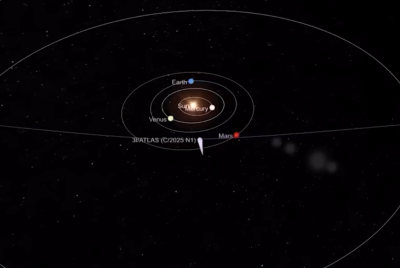3I/ATLAS Nears Earth—Experts Claim Comet Is A Window To Galaxy's Past
Rare interstellar comet 3I/ATLAS is approaching Earth. Learn about this ancient visitor before it vanishes forever in 2025.

Look up at the early morning sky towards the constellation Virgo, and you are staring into the abyss of history. But right now, hidden within that darkness is a visitor that has travelled farther than the human mind can comfortably comprehend. It is a cosmic relic, a ghost from an era before our own Solar System even ignited into existence.
While most comets we see are local residents returning home, this object is an interstellar traveller, piercing through our neighbourhood for a brief, historic moment.
It is the rare and special comet known as 3I/ATLAS, the third confirmed interstellar object ever detected, following the mysterious 1I/'Oumuamua in 2017 and the comet 2I/Borisov in 2019, and it has captured the undivided attention of astronomers and stargazers across the globe.

Global Eyes And Lenses Fixated On 3I/ATLAS
Currently, this celestial wanderer sits at a staggering distance of a little more than 300 million kilometres (186 million miles) away from Earth. While that expanse of space might seem insurmountable to the layperson, it is close enough for the world's most sophisticated technology to lock onto it.
The scientific community is buzzing with activity; updates, videos, and new images are streaming in almost every day as humanity tries to document this once-in-a-lifetime event.
The observation efforts are truly interplanetary. Satellites from the European Space Agency (ESA) have been tracking the comet from Mars' orbit, joined by a fleet of NASA spacecraft preparing to turn their sensors towards the object. This includes the James Webb Space Telescope, the most powerful space observatory ever built.
Already, on October 2 and 3, three NASA spacecraft near the Red Planet —including the Mars Reconnaissance Orbiter (MRO) and MAVEN— captured photographs of the comet as it passed around 29 million kilometres (18 million miles) from Mars.
These images reveal a small, fuzzy white spot—the classic signature of a fast-moving comet viewed from a great distance.
On the ground, astronomers are just as busy. In Italy, the Virtual Telescope Project managed to zoom in and share new pictures, proving that even from the surface of our planet, 3I/ATLAS is within reach.
While you currently need binoculars or a telescope to spot it low on the eastern horizon in the early morning sky, the race to observe it is heating up. As NASA's acting astrophysics director, Shawn Domagal-Goldman, said, 'Everyone who has a telescope wants to look at it because it's a very rare chance'.

Debunking The Rumours: What 3I/ATLAS Is (And Isn't)
Whenever an object from deep space enters our system, the imagination tends to run wild. Because 3I/ATLAS looks unusual compared to the standard comets we are used to, the internet became a breeding ground for speculation.
Many rumours started online saying it might be a spacecraft or something artificial, sparking theories of extraterrestrial visitation.
However, science has stepped in to clarify the mystery. NASA quickly ended these rumours, saying clearly that 3I/ATLAS is just a natural comet. It is not an alien envoy, but a rock and ice traveller. NASA's Amit Kshatriya added, 'The space agency is always searching for signs of life, but 3I/ATLAS is a comet'.

Unlocking The Ancient Secrets Of 3I/ATLAS
The true nature of this comet is far more exciting than fiction. Scientists believe 3I/ATLAS may be between 440 metres and 5.6 kilometres wide. Its speed of 210,000 kilometres per hour (130,000 mph) and behaviour suggest that it may have formed in a star system older than our own, estimated to be between 5 and 10 billion years old. This offers a unique opportunity: studying it can tell us more about the early days of the galaxy—even before the Sun and Earth were formed.
It acts as a window into the past, a pristine sample of the universe's chemistry from eons ago. The implications of this are profound. NASA scientist Tom Statler said that thinking about this 'gives me goosebumps'.
The Final Approach Of 3I/ATLAS In 2025
The window to view this object is closing, albeit slowly. The closest 3I/ATLAS will come to Earth is around 269 million kilometres in mid-December 2025, specifically on December 19. This date marks the climax of its visit. After that, gravity will fling it back out into the void, and it will move away again and head back into deep space, never to return.
Even spacecraft with other missions are taking a peek. ESA's Juice spacecraft, which is traveling toward Jupiter, has also been studying the comet for weeks.
However, we will have to wait for those specific findings. Its data will only arrive in February because the spacecraft is currently using its main antenna as a heat shield while it is near the Sun.
As 3I/ATLAS continues its journey past Earth, scientists will keep watching it closely. This is a once-in-a-lifetime chance to learn more about objects that travel between the stars.
As 3I/ATLAS speeds towards its final departure, we are reminded of the fleeting nature of these cosmic encounters. This is not merely an astronomical event; it is a brief intersection with a history older than our own world.
© Copyright IBTimes 2025. All rights reserved.




















